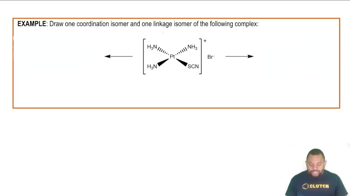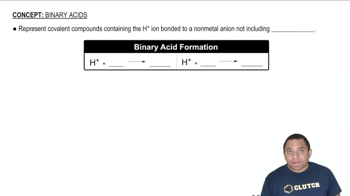Ch.23 - Organic and Biological Chemistry
Chapter 23, Problem 91
There are two isomeric fat molecules whose components are glycerol, one palmitic acid, and two stearic acids (see Table 23.3). Draw the structures of both, and explain how they differ.
 Verified step by step guidance
Verified step by step guidance1
Step 1: Understand the components of the fat molecules. Glycerol is a three-carbon alcohol with three hydroxyl (OH) groups. Palmitic acid is a saturated fatty acid with 16 carbon atoms, and stearic acid is a saturated fatty acid with 18 carbon atoms.
Step 2: Recognize that the fat molecules are triglycerides, which are formed by esterification of glycerol with three fatty acids. In this case, one palmitic acid and two stearic acids will be esterified with glycerol.
Step 3: Draw the structure of glycerol, which is a three-carbon chain with each carbon bonded to a hydroxyl group. This will serve as the backbone for the triglyceride.
Step 4: Attach the fatty acids to the glycerol backbone. For the first isomer, attach the palmitic acid to the first hydroxyl group of glycerol and the two stearic acids to the remaining two hydroxyl groups.
Step 5: For the second isomer, attach one stearic acid to the first hydroxyl group, the palmitic acid to the second hydroxyl group, and the other stearic acid to the third hydroxyl group. This arrangement will create a different isomeric structure.
Key Concepts
Here are the essential concepts you must grasp in order to answer the question correctly.
Isomerism
Isomerism refers to the phenomenon where two or more compounds have the same molecular formula but different structural arrangements or spatial orientations of atoms. In the context of fat molecules, isomers can differ in the arrangement of fatty acid chains around the glycerol backbone, leading to variations in physical and chemical properties.
Recommended video:
Guided course

Isomerism in Coordination Complexes Example
Fatty Acids
Fatty acids are carboxylic acids with long hydrocarbon chains, which can be saturated or unsaturated. In this question, palmitic acid (a saturated fatty acid) and stearic acid (also saturated) are components of the fat molecules. The arrangement of these fatty acids in relation to the glycerol molecule influences the properties of the fat, such as melting point and stability.
Recommended video:
Guided course

Binary Acids
Glycerol Structure
Glycerol is a three-carbon alcohol that serves as the backbone for triglycerides, which are the main constituents of body fat in humans and animals. The structure of glycerol allows it to form ester bonds with fatty acids, resulting in different types of triglycerides. The positioning of the fatty acids on the glycerol molecule is crucial for distinguishing between isomeric forms.
Recommended video:
Guided course

Resonance Structures
Related Practice
